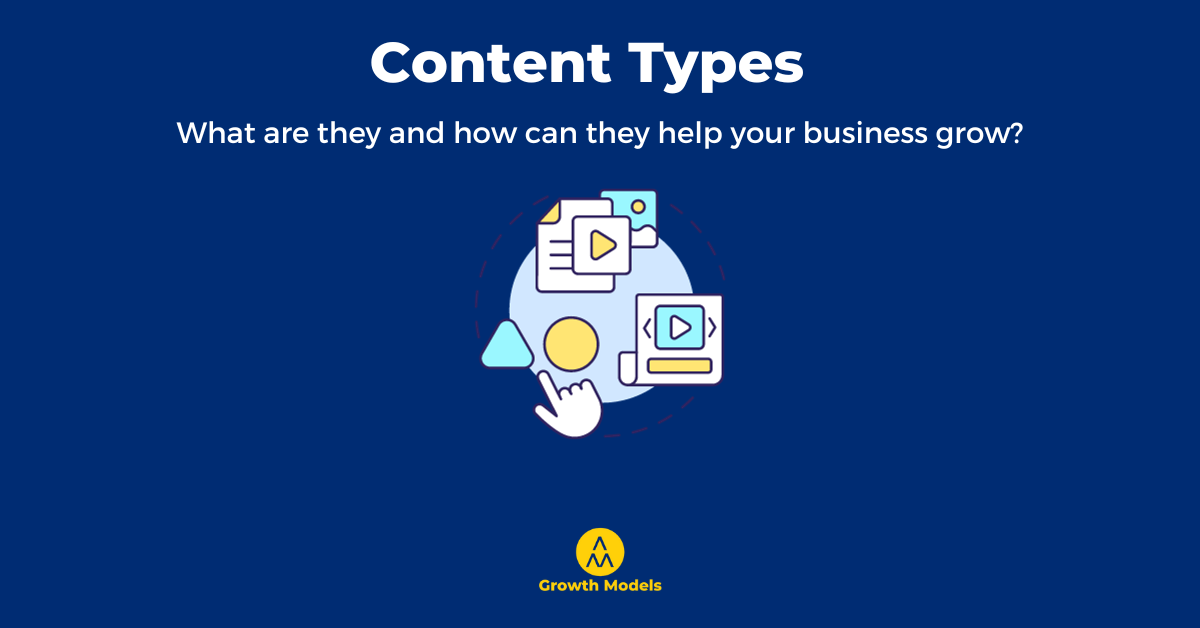There’s a lot of content you could be producing for your brand. but where should you start?
Well, I recently published a breakdown of the 4 content categories you should focus on. However, there’s another layer to this. Content types.
By content types, I mean the format you should be adopting when creating different pieces of content.
In this piece, I want to follow on from my prior piece and explain the different content types and formats and where they’re best used.
A quick caveat on the “right” content types
The below breakdown of content types are suggestions.
There are some content formats that are pretty versatile. For example, video.
Video can be used across all of the different content categories to great effect.
The suggestions below are around where these types of content are either most effective or most commonly used. You can, with a little ingenuity, make these kinds of content fit different uses.
With that out of the way, let’s get into it.
The 17 content types and how you can use them to grow your brand
Below I’ve listed (and will continue to add) different content types and formats.
In addition to listing the type of content, I’ve also listed…
- Some basic info
- Pros and cons of the content type
- Where it often sits in the content categories
- And a few other pieces of info I thought would be helpful
If you’ve not read the piece on content categories yet, here’s an image that summarises the 4 content categories you should be producing.

Now, let’s get into the types.
1. Blog posts
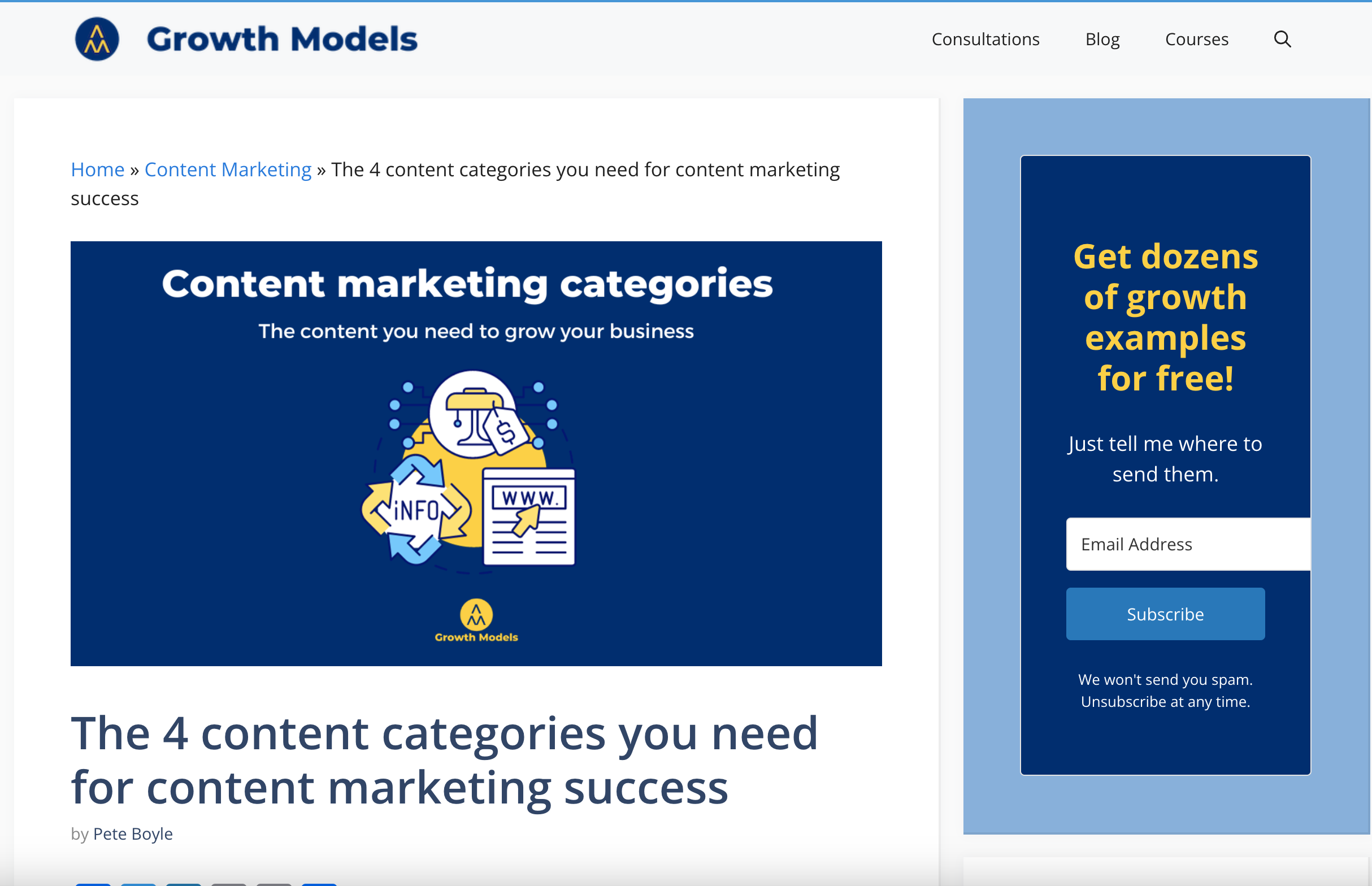
You know what a blog post is you’re reading one now.
These have been the core of many brands’ content marketing efforts for years.
I don’t think I really need to explain them, but as a summary blog posts are a simple written version of the content to be published.
Kind of topics blog posts can cover
Blog posts are super versatile. You can use them to cover a lot of different content topics.
The most common uses of blog content are…
- Thought leadership posts
- Content that answers user questions
- “Proof” building pieces that show how you achieved something
- Product demo pieces that are “how-to” guides showing the value of your product
You can also publish things like case studies as blog posts, however, I don’t think they work that well. Personally, I think they’re better off as a “how we did X and how you can too” type post.
Pros of blog posts
- They’re versatile. You can tackle different topics and cover many different angles through written blog content.
- Can passively attract traffic. Blogging allows you to optimize your website for relevant keywords and improve your search engine rankings. Regularly publishing high-quality blog posts can help you rank higher in search engine results pages and bring good traffic to you.
- Distribution options. One long-form blog post can be chopped and changed into multiple different promotional assets to help you drive more traffic and build better awareness on social.
- Cost-effective. Compared to traditional advertising methods, blogging is a cost-effective marketing strategy. It requires minimal financial investment but can yield significant results in terms of website traffic, brand awareness, and lead generation.
- Long-lasting impact: Unlike some other forms of content marketing, blog posts have a longer lifespan.
Cons of blog posts
- Lack of credibility. With the ease of creating and publishing blog posts, it can be difficult to determine the credibility and expertise of the author. A lot of bad advice is floating around out there on blogs.
- Can be overwhelming. A lot of people target the wrong things with blog posts meaning they spend a lot of time creating something that doesn’t drive business results (following a system like this one can help you avoid a similar fate).
- Time-consuming. While you can create blog content on a very limited and non-existent budget, you are going to need time. Creating high-quality blog posts requires a significant amount of time and effort. This can be a disadvantage for creators and brands who have limited resources or busy schedules.
- Declining popularity. While blogging remains a popular medium, it has faced competition from newer platforms and formats such as social media and video content. This can make it harder for creators and brands to stand out and attract a sizable audience.
- A lot of AI competition now. With the rise of AI, a lot of people are spitting out content at a rapid pace. Meaning people without top quality content are seeing their rankings drop.
2. Long-form video
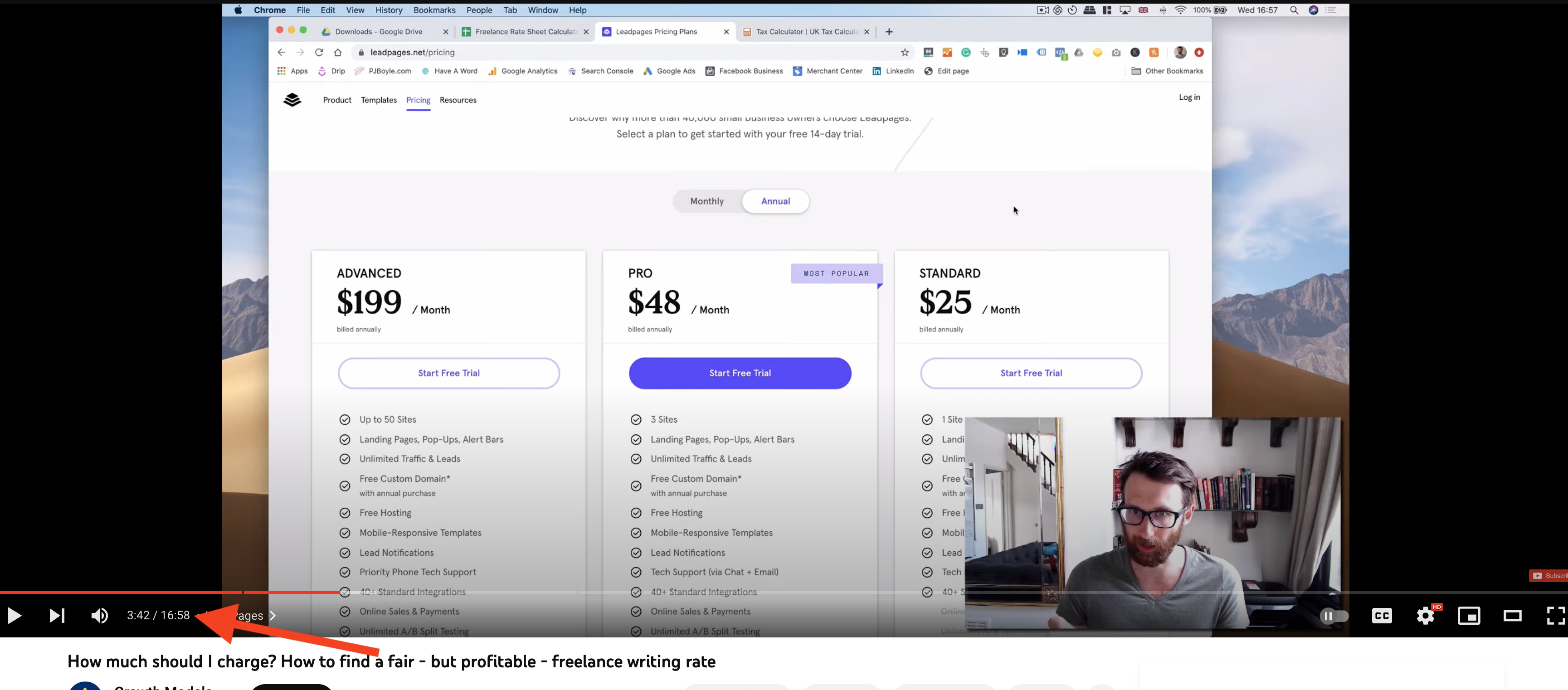
This is where I think a lot of the future of content marketing will be.
Long-form video is any video (IMO) over 4 minutes long. The kind of stuff you see on YouTube.
The reason I think that this going to be the future is, thanks to AI creators coming up, people are going to gravitate to more verifiable expertise. And a real person giving you advice will be a way to stand out from he AI bros out there.
Content topics long-form video can cover
Much like written blog posts, this is a very versatile content format. I don’t think there’s anything video can’t do to be honest.
You can use it to create content that attracts users searching for a solution. You can use it to sell (see VSLs below). You can use it for interviews, case studies, reviews and so much more.
Video is going to be the biggest content format in the future IMO.
Pros of long-form video
- Allows for in-depth storytelling. Long-form videos provide creators and brands with the opportunity to tell a more comprehensive and detailed story. They can delve into complex topics, explore different angles, and engage the audience on a deeper level.
- Builds brand credibility and expertise: Long-form videos give creators and brands the chance to showcase their knowledge and expertise in a particular field. By providing valuable and in-depth content, they can establish themselves as trusted authorities and build credibility among viewers.
- Enhances audience retention and engagement: Long-form videos have the potential to capture and retain the attention of viewers for an extended period. By providing valuable and engaging content, creators and brands can keep the audience hooked and encourage them to watch till the end.
- Fosters deeper connections with the audience: By investing time and effort into creating long-form videos, creators and brands can establish a deeper connection with their audience. This connection can lead to increased loyalty, brand advocacy, and a stronger community around the content.
- Super versatile: I honestly cannot think of something that video marketing cannot do. You can create shorts form it to get traffic from social, cover any topic, and even generate passive traffic thanks to YouTube and other search engines ranking video higher.
Cons of long-form video
- Limited attention span: Long-form video content may not hold the audience’s attention for an extended period of time, especially in today’s fast-paced digital world where shorter content is preferred.
- Higher production costs: Creating long-form video content typically requires more resources, including a larger production team, equipment, and editing time, which can be costly for brands and creators.
- Difficulty in maintaining engagement: It can be challenging to keep viewers engaged throughout a long video, leading to a higher likelihood of drop-offs and lower completion rates.
- Reduced discoverability: Search engines and social media algorithms often prioritize shorter videos, making it more challenging for long-form content to be discovered by new audiences.
3. Short-form video
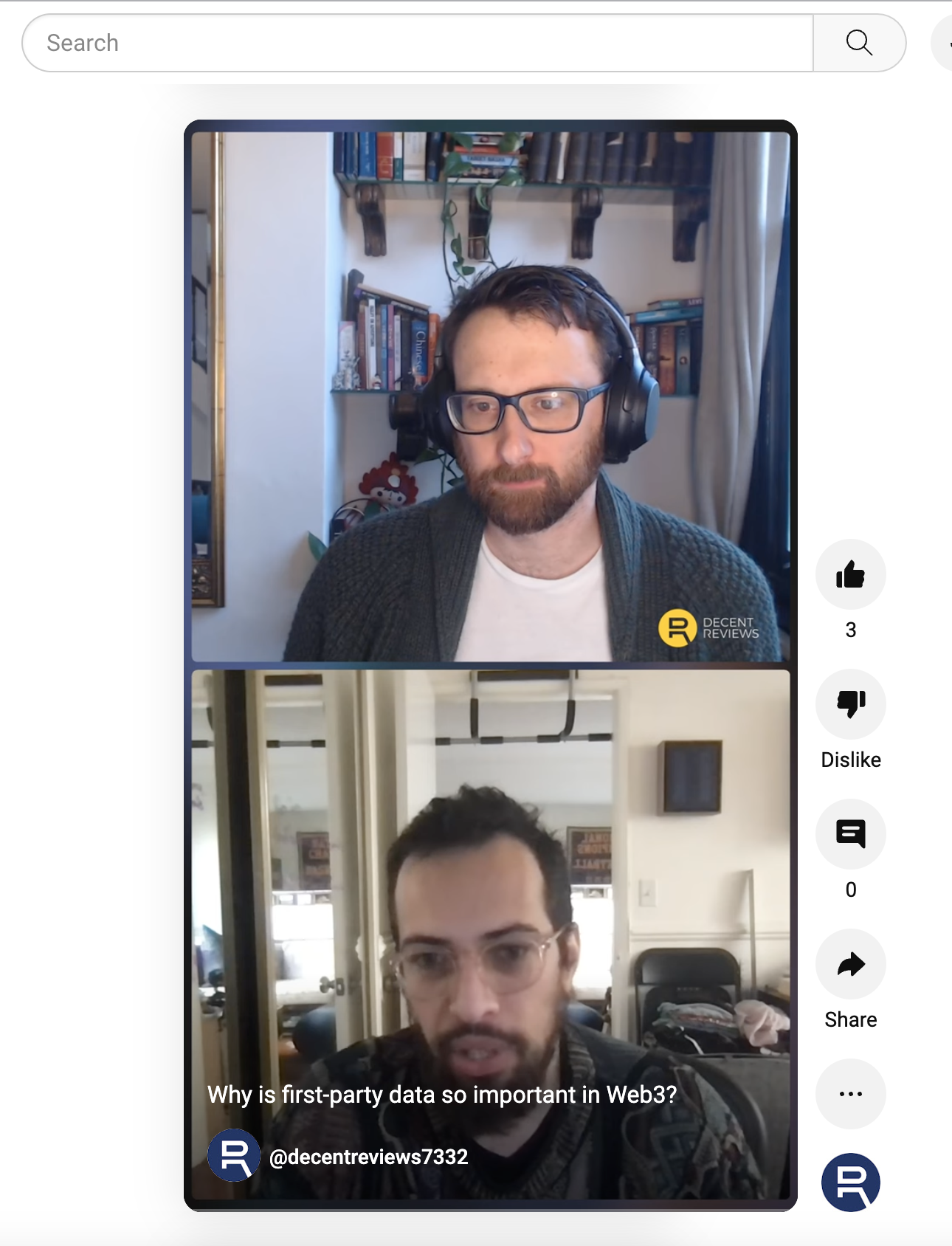
Short-form video is, IMO, anything that’s below 4 minutes long.
Realistically though we’re talking much shorter. If you look at platforms like TikTok, YouTube shorts, and even things like Instagram reels you’ll get an idea of what I mean.
Short-form videos are those super short format vids that are basically there to grab attention and get some views from people.
Content topics short-form video can cover
It’s a little difficult to pin down the strong suit for short-form video IMO.
It’s not great for in-depth explanations or detailed analysis because it’s so short.
What I do think it’s great for is driving attention. Shorts and reels get a lot of views. If you can create a short that generates enough interest with users, they should then move to your longer-form content to learn more.
It’s similar to moving people from rented to owned audience.
Shorts are there to drive traffic to the longer form content that will help;p you convert them to being monetised.
Pros of short-form video content
- Attention-grabbing: Short form video content has the ability to capture viewers’ attention quickly due to its concise and condensed format.
- Increased engagement: Short videos are more likely to be watched in their entirety, leading to higher engagement rates and increased interaction with the brand or creator.
- Shareability: Short videos are highly shareable across various social media platforms, allowing brands and creators to reach a wider audience and potentially go viral.
- Creativity and experimentation: The shorter format of videos allows brands and creators to experiment with different ideas, styles, and formats, fostering creativity and innovation in their content.
Cons of short-form video content
- Limited Time for Content Development: Short-form videos typically have a time constraint, which can limit the depth and complexity of the content that brands and creators can deliver.
- Lack of Detailed Information: Due to the short duration, it can be challenging to provide comprehensive information or convey complex concepts effectively.
- Potential Lack of Context: With limited time, it may be difficult to provide the necessary context or background information, which can lead to misunderstandings or confusion among viewers.
- Lower Conversion Rates: Short-form videos may not have sufficient time to capture the audience’s attention or persuade them to take a desired action, leading to lower engagement and conversion rates.
4. Social posts
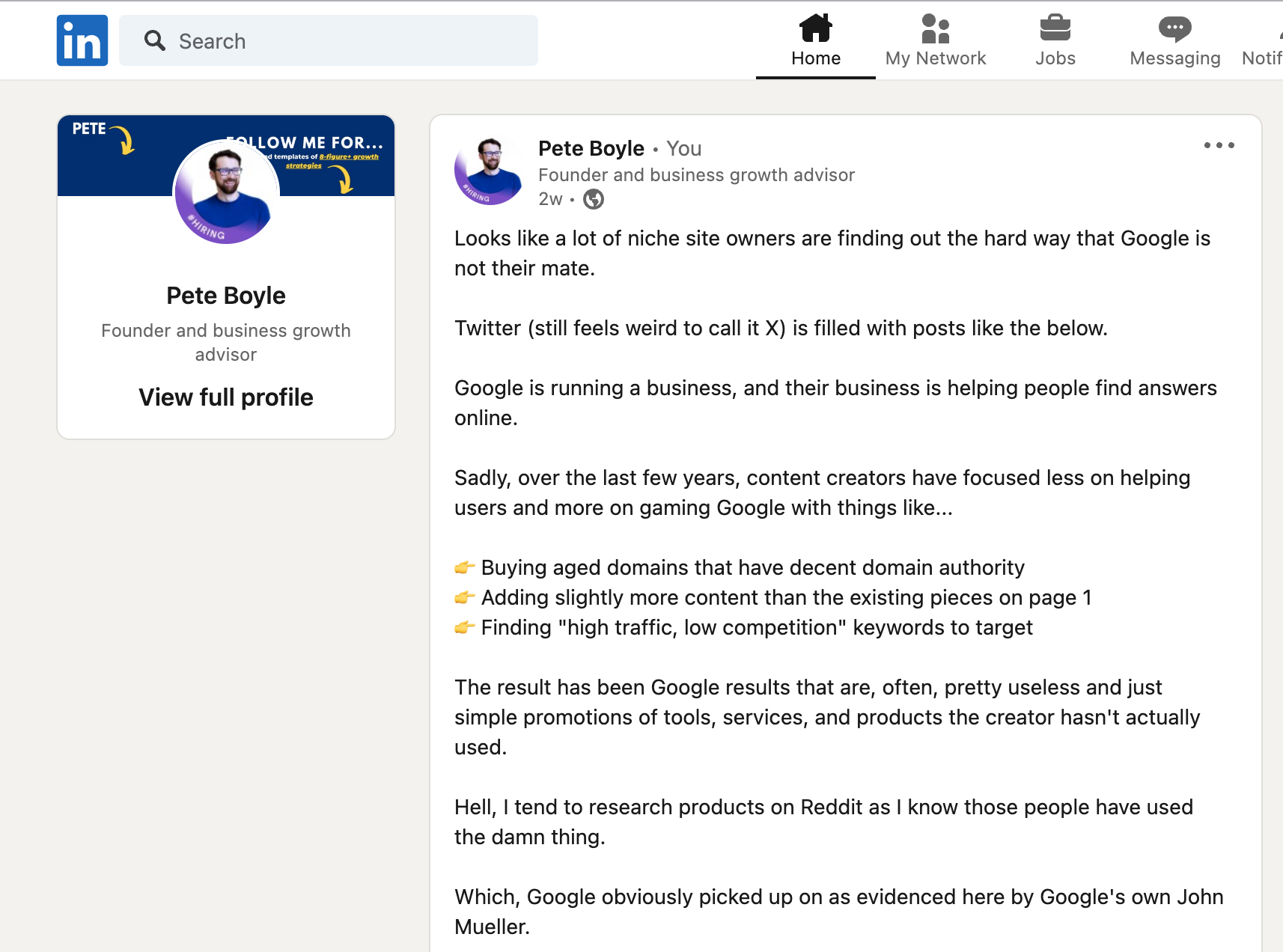
Social media marketing has become a core aspect of content marketing for many.
While most use it to funnel traffic to their owned assets (see above image) there are some who can generate enough engagement on social platforms that their account becomes the core asset of their business.
I mean, if you can get 100,000 engagements per week, brands will pay you to feature their products.
Content topics for social media posts
It wasn’t so long ago that you were limited to short-form thoughts and soundbites for social.
That still can be the case,e but thanks to things like X/Twitter threads and long-form FB and LinkedIn posts, you can offer some decent depth to your posts.
As a result, you can cover quite a lot with social media across the various content types. From building trust to showing proof, and even attraction content.
However, I always recommend that you don’t rely solely on social.
Move people from social to your own owned channels. If the social brand changes their algorithm or bans your account, you can lose everything overnight.
But if you’ve moved them to your email list, they’re yours forever.
Pros of social media content
- Increased Brand Awareness: Social media content marketing allows brands and creators to reach a larger audience and increase their visibility. By staying top of mind you make it easier to attract and convert customers.
- Cost-Effective: Compared to traditional marketing methods, social media content marketing is relatively low-cost, making it accessible for brands and creators with limited budgets.
- Increased Website Traffic: Sharing content on social media platforms helps drive traffic to a brand or creator’s website, increasing the chances of conversions and sales. As mentioned, this is what you should be doing. Move your audience off social to where you have more control over the relationship.
- Viral Potential: Social media content has the potential to go viral, reaching a massive audience and generating widespread attention and brand exposure. But virality is pretty rare and almost impossible to guarantee.
- Fast feedback loops: Social is great for getting quick feedback on whether or not something is valuable to your users. It’s a low-stakes game where you can test the waters quickly and easily before making larger investment decisions.
Cons of social media content
- Oversaturation: With the vast amount of content being produced and shared on social media, it can be challenging for brands and creators to stand out and capture the attention of their target audience.
- Difficulty in measuring ROI: While social media platforms offer various analytics and insights, it can still be challenging to accurately measure the return on investment (ROI) of social media content. This can make it difficult for brands and creators to evaluate the effectiveness of their efforts.
- Algorithm changes: Social media platforms frequently update their algorithms, which can impact the visibility and reach of content. Brands and creators may need to constantly adapt and adjust their strategies to keep up with these changes.
- Dependence on platform policies: Brands and creators are subject to the policies and guidelines of social media platforms. Any violation of these policies can result in content removal, account suspension, or even permanent bans, limiting their ability to connect with their audience.
- Lack of control over content ownership: When posting content on social media platforms, brands and creators may relinquish some control over their intellectual property. There is a risk of unauthorized use or replication of their content by others without proper attribution or permission.
5. Webinars / Free training videos

I’ve grouped these two together as they are, essentially, the same thing.
Sometimes live, sometimes pre-recorded. The goal of both is to engage the user with a long-form video that outlines a solution to a specific problem.
Webinars are the preferred terminology for B2B, and a lot of B2C brands use a free training terminology. tey are, essentially the same thing.
I use them to generate leads for this business as you can see here with this content marketing training.
Because they’re focused on a specific problem they’re great for highlighting a specific cohort with a real problem, which is like a person raising their hand saying “I need this solved”. Great, targeted lead gen.
Content topics for webinars and free trainings
You’re a little more limited with content topics here.
You’re really looking to feature a prime problem your ideal users face. If you’re not helping them solve a problem, it’s not worth being put into this format.
I mean, would you give up 1 hour of a specific time slot to hear people talk about something that doesn’t affect or help you?
No.
You want to focus this on the kind of things that keep people up at night and you can help them solve.
Pros of webinars and free trainings
- Increased Reach: Webinars allow brands or creators to reach a larger audience as they can be accessed by participants from anywhere in the world.
- Expert Positioning: Webinars provide an opportunity for brands or creators to showcase their knowledge and expertise in a specific field, helping to establish them as industry leaders and build credibility.
- Lead Generation: Webinars often require participants to register, providing brands or creators with valuable lead information that can be used for future marketing efforts. And these leads are often super qualified as they want to solve the problem you’re highlighting.
- Interactive Engagement: Webinars allow for two-way communication between hosts and participants through Q&A sessions, polls, and live chat, fostering engagement and building stronger connections with the audience.
- Repurposable Content: Webinars can be recorded and repurposed as on-demand content, allowing brands or creators to extend the reach and longevity of their message beyond the live event.
Cons of webinars and free video trainings
- Limited Interaction: Unlike in-person events, webinars lack the personal touch and direct interaction between the brand/creator and the audience. Participants may not feel as engaged or connected with the content or the speaker.
- Technical Issues: Webinars heavily rely on technology, and technical glitches such as poor internet connection, audio/video problems, or software malfunctions can disrupt the flow of the webinar and negatively impact the viewer’s experience.
- Time Constraints: Webinars are typically scheduled for a specific time and duration, which may not be convenient for all viewers. This can result in lower attendance rates and missed opportunities to reach a wider audience.
- Lack of Visual Cues: Non-verbal communication, body language, and visual cues play a significant role in effective communication. In webinars, these cues may be limited or absent, making it harder for brands/creators to gauge audience reactions and adjust their presentation accordingly.
- A Little Played Out: The whole approach to webinars has been heavily used for the last few years and it’s become a little tired. To do well with it, you need to make sure you’re really focusing on a painful problem for users.
6. VSLs (video sales letters)

This is essentially a sales page in video form.
In fact, a lot of brands I know of just put the script for the VSL as a written version below it.
Some of the highest-performing VSLs are pretty long (I’ve analysed them before which you can read here). And they often form part of a paid ads funnel.
Ads > Email capture > VSL > Nurture and sale
They’re similar to webinars and free training videos, however, there’s a bigger focus on getting the sale. The primary goal is not to inform, but to persuade to buy.
Content topics for VSLs
There’s really only one content topic for the VSL.
You need to create something that makes people want to buy.
You’ll be looking at using a tried and tested template for this (I’ll produce some templates for you to use).
It’s essentially a sales page in video form.
Pros of
- Increased Engagement: VSLs have the potential to captivate viewers and keep them engaged throughout the entire video, increasing the chances of converting them into customers.
- Effective Storytelling: VSLs provide creators and brands with the opportunity to tell a compelling story that resonates with their target audience, creating a stronger emotional connection and enhancing brand loyalty.
- Visual Appeal: By combining visuals, animations, and text, VSLs can deliver information in a visually appealing and dynamic manner, making it easier for viewers to understand and remember the key messages.
- Conversion Optimization: VSLs are known for their ability to drive higher conversion rates compared to traditional written sales letters. The combination of visuals, persuasive storytelling, and a clear call to action can significantly increase the likelihood of viewers taking the desired action, such as making a purchase or signing up for a service.
- Versatility: VSLs can be easily shared and distributed across various platforms, including websites, social media, email campaigns, and more. This versatility allows creators and brands to reach a wider audience and maximize their marketing efforts.
Cons of VSLs
- Limited creative control: With VSLs (Video Sales Letters), creators and brands may experience limited creative freedom compared to other video formats. The structure and format of VSLs often follow a specific formula, which may restrict the ability to showcase unique branding or creative ideas.
- Lack of personal connection: VSLs are typically pre-recorded and lack the personal touch that can be achieved through live presentations or interactions. This can make it challenging for creators and brands to establish a genuine connection with their audience, potentially leading to lower engagement and conversion rates.
- Potential for viewer fatigue: VSLs often have a longer duration, typically ranging from 15 to 60 minutes, which can lead to viewer fatigue and decreased attention span. This may result in reduced effectiveness in conveying the intended message or call-to-action.
- Higher production costs: Creating a high-quality VSL often requires professional video production, voiceover talent, and extensive editing. These additional production costs can be a significant investment for creators and brands, especially if they are just starting or have limited resources.
- Limited opportunity for real-time feedback: Unlike live presentations or interactive videos, VSLs do not provide immediate feedback or engagement opportunities. Creators and brands may miss out on valuable insights and customer feedback that can help improve their offerings or marketing strategies.
7. Newsletters

Newsletters have become a go-to for many brands over the last few years. After the success of brands like Morning Brew and The Hustle (both of which I’ve analysed) everyone wanted to start a quick and easy newsletter.
Most of them are curated news in the space (which I think will soon become obsolete thanks to AI), but there are some that have unique takes and genuine analysis.
They’re usually sent on a set cadence. Could be daily, weekly, or monthly. And they’re often focused on one specific topic.
A few people are doing well with this as their main business model, however, it requires a lot of subscribers and high engagement rates to make decent money.
I’m personally of the opinion that email to drive users to paid products is a better way to grow.
Content topics for Newsletters
This is an odd one.
A lot of the newsletter approaches right now are top and mid-funnel content. They’re simply curated lists of recent news and developments within a space.
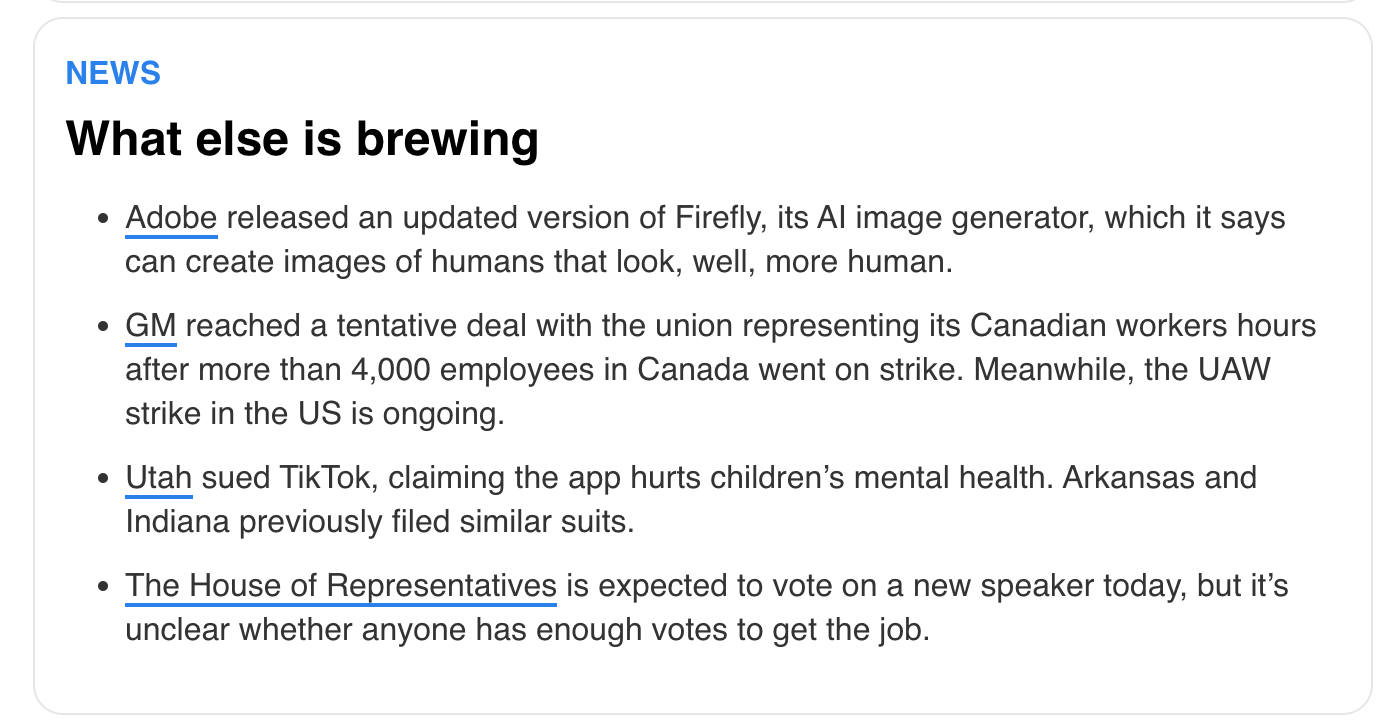
They’re there really to make it easier for people to find impactful news and save time having to scroll through news sites.
There’s little in the way of conversion-focused stuff and it’s often a play for eyeballs and attention. This means monetisation is only really achieved through affiliate deals or sponsorships.
Both of which require good engagement numbers.
Pros of newsletters
- Increased Brand Awareness: Newsletters provide a platform for creators and brands to consistently reach their audience, allowing them to build brand recognition and stay top-of-mind.
- Low Cost: All you really need to run an effective newsletter is an account on a good ESP like ConvertKit and the time to write the content. IUf you can manage that, you’ve got the foundations of a good business.
- Targeted Marketing: With newsletters, creators and brands can segment their subscriber list based on specific interests or demographics, enabling them to tailor their content and promotions to different segments, leading to higher conversion rates.
- Driving Website Traffic: By including links to their website or specific landing pages in newsletters, creators and brands can drive traffic to their online platforms, increasing visibility and potentially generating sales or conversions.
- Showcasing Expertise: Newsletters provide a platform for creators and brands to share valuable and insightful content, positioning themselves as industry experts and thought leaders within their niche.
Cons of newsletters
- Overwhelming Inbox: Newsletters can contribute to an already cluttered inbox, making it difficult for subscribers to keep up with important emails.
- Spam Filters: Newsletters often get caught in spam filters, preventing them from reaching subscribers’ primary inbox and reducing their visibility.
- Content Fatigue: Frequent newsletters can lead to content fatigue, where subscribers become disinterested or overwhelmed by the constant flow of information, causing them to ignore or delete newsletters without reading them.
- Lack of Personalization: Generic newsletters that do not cater to the specific interests or needs of subscribers may fail to engage or resonate with them, resulting in reduced effectiveness.
- Ineffective Calls to Action: If newsletters do not have clear and compelling calls to action, subscribers may not take the desired actions, such as making a purchase or engaging with the brand or creator’s content. A lot of people are only really monetising through sponsorships which makes this really important.
8. Email
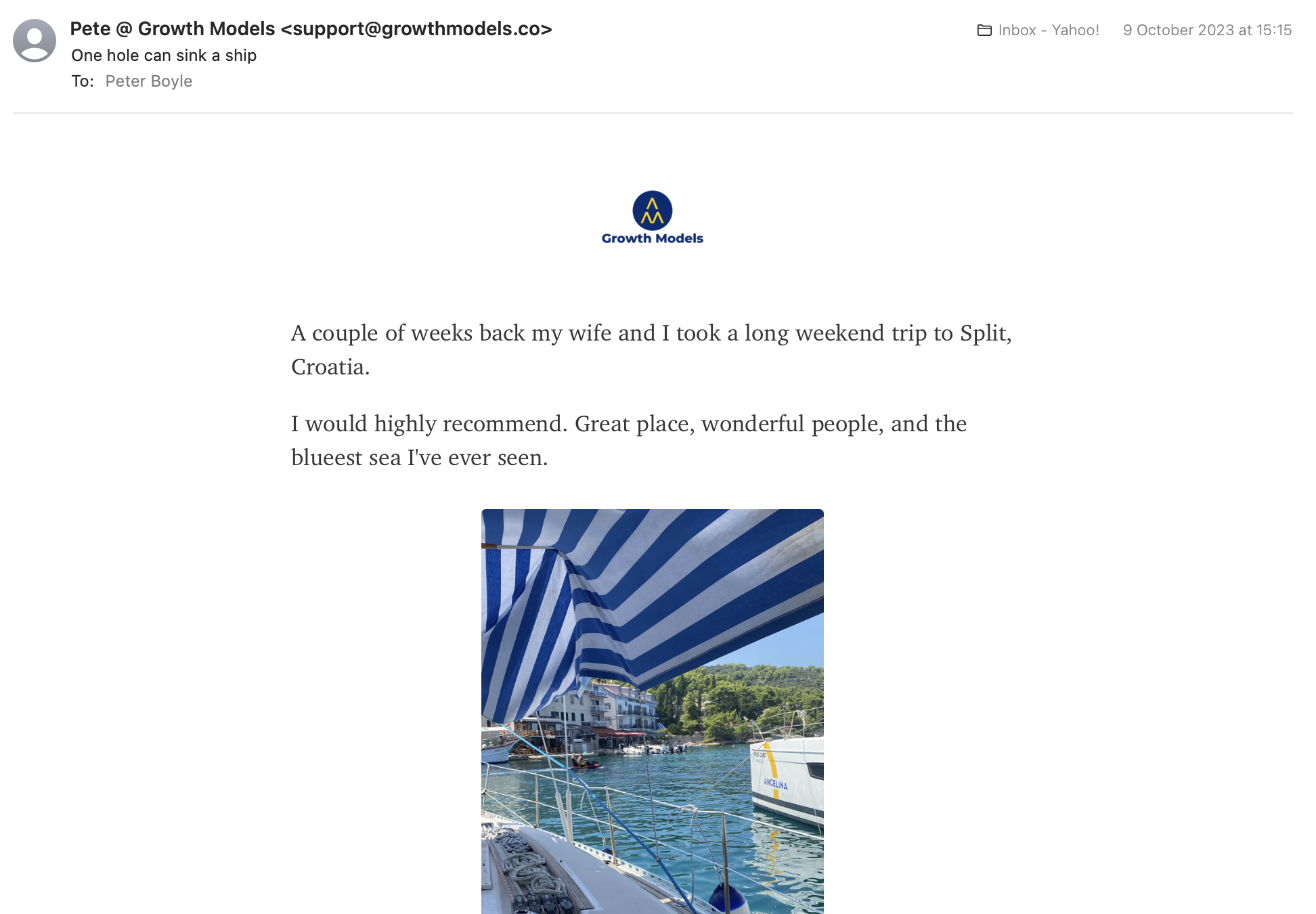
Email marketing is one of, if not my favourite, channel.
I differentiate this from newsletters as a newsletter is one form of email marketing. IMO, email marketing also encompasses things like…
- Automated email sequences
- Product launch announcements
- Newsletters
And so much more.
Email is incredibly versatile if you know what you’re doing and, despite the busy-ness of many people’s inboxes, you can cut through the noise and do well with it. It’s always been my highest-converting channel.
Content topics for email marketing
Email is pretty versatile. You can’t really use it for generating buzz or even attracting users through search.
Even though a lot of email tools allow you to publish your emails for all to see and for Google to rank, they never seem to rank well.
You can see the example of this here with my own newsletter.
However, I don’t think there’s anything better than email for nurturing relationships and getting the sale. It’s one of the best relationship builders and traffic-shaping channels IMO.
I email my list regularly to help them out, keep them updated, and tell them where they can buy things from me.
Pros of email marketing
- Cost-effective: Compared to traditional marketing channels, email marketing is relatively inexpensive and doesn’t require printing or postage costs.
- Personalization: You can personalize each email to cater to the specific needs and interests of your subscribers, increasing engagement and conversion rates.
- Easy to track and measure: Email marketing platforms provide detailed analytics, allowing you to track open rates, click-through rates, and conversion rates, helping you make data-driven decisions. This is getting a little harder now in terms of tracking opens, but you can still track which emails drove sales which is the real issue.
- Automation: With email marketing automation, you can set up automated campaigns and workflows, saving time and effort while maintaining consistent communication with your audience.
- Higher ROI: Email marketing has one of the highest returns on investment (ROI) among marketing channels. It is cost-effective and has the potential to generate significant revenue through increased sales and customer retention.
Cons of email marketing
- Potential for Spam: Email marketing runs the risk of being perceived as spam by recipients, which can damage the reputation of your brand and result in low open rates and unsubscribed.
- Deliverability Issues: Email deliverability can be a challenge due to various factors such as spam filters, technical issues, and changing algorithms. This can result in emails being blocked or sent to the spam folder, reducing the effectiveness of your campaigns.
- Opt-Outs and Unsubscribes: Despite efforts to provide valuable content, some recipients may still choose to opt-out or unsubscribe from your emails. This can lead to a decline in your email subscriber list, making it harder to grow and maintain a large and engaged audience.
- Difficult growth: Getting people to subscribe to your email list can be hard. You’re asking them to hand over personal information and, as a result, a lot of email lists remain small which drastically impacts monetisation potential.
- Dependence on Email Service Providers: Email marketing relies heavily on email service providers (ESPs), and any issues or changes in their policies can impact your campaigns. This dependence can make it challenging to adapt quickly to new regulations or technological advancements.
9. Case studies
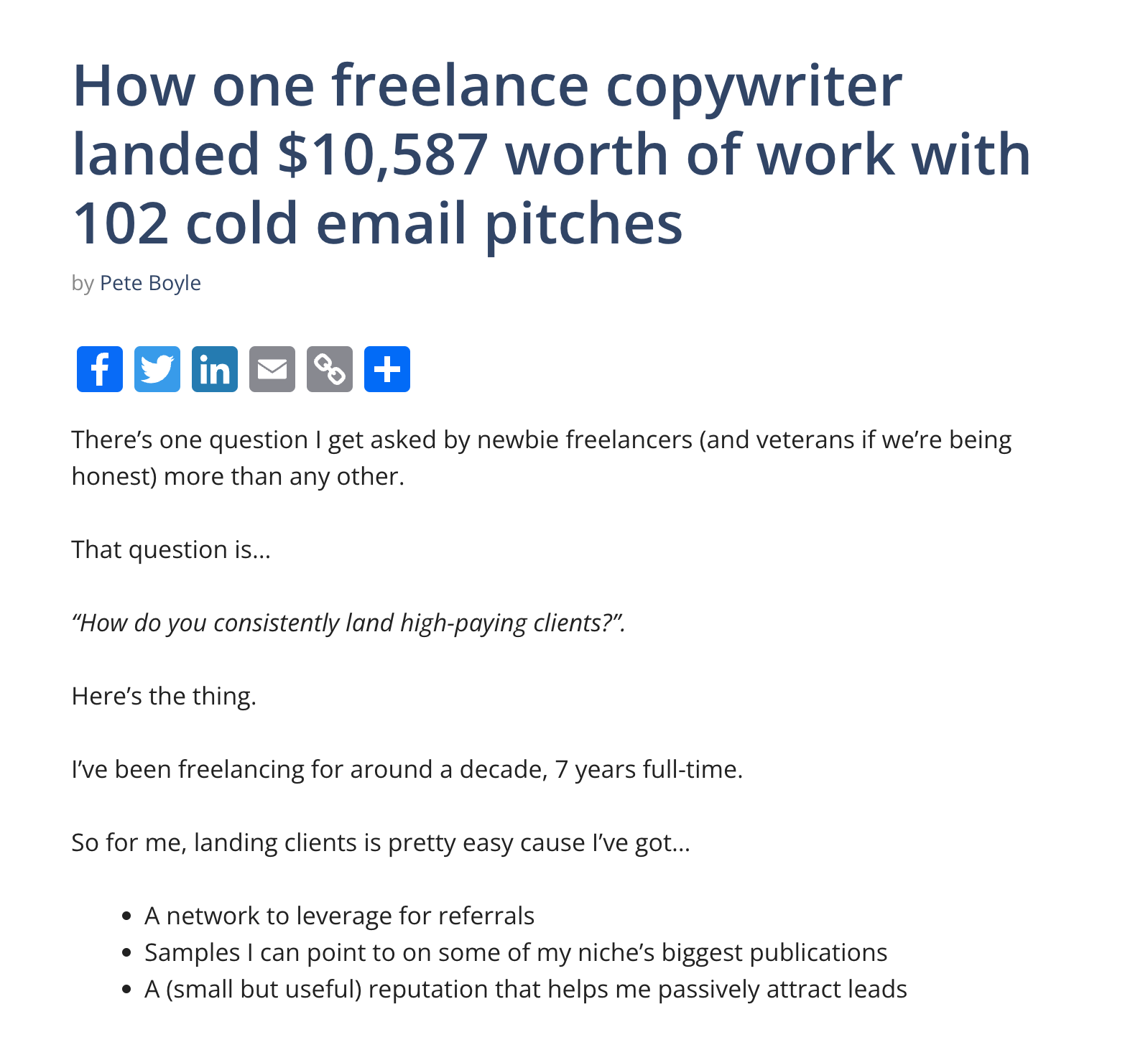
Case studies have long been the go-to asset for brands who want to prove they can do the thing.
You basically write a simple explanation which, usually, covers…
- About the brand you helped
- The challenge they faced and what it was costing them
- The solution you implemented
- The results you generated
They’re usually used by brands selling a B2B service. You write about how you helped client A to convince client B you’re worth their money.
Content topics for case studies
You’re super limited here.
Case studies are generally bottom-of-the-funnel type deals used to prove you can do the job and that a brand investing in you isn’t going to be wasted money.
They are, in my opinion, there to help you stand out against the competition when the customer/client is at the stage of choosing a vendor for a service.
Pros of case studies
- In-depth understanding: Case studies provide a comprehensive analysis of a brand or creator’s strategies, allowing for a deeper understanding of their successes and failures.
- Real-life examples: Case studies offer real-life examples of how brands and creators have overcome challenges, providing valuable insights and inspiration for others.
- Practical application: The lessons learned from case studies can be directly applied to improve marketing strategies, content creation, and brand positioning.
- Building credibility: Successful case studies can enhance a brand or creator’s credibility, showcasing their expertise and track record of delivering results.
- Problem-solving approach: Case studies present challenges faced by brands and creators, along with the solutions implemented, providing a problem-solving approach for similar situations.
Cons of case studies
- Limited Generalizability: Case studies are often specific to a particular brand or creator, making it difficult to generalize the findings to a broader audience or industry.
- Subjectivity: Case studies rely heavily on subjective interpretation and analysis, which can introduce bias and affect the objectivity of the results.
- Time and Resource Intensive: Conducting comprehensive case studies can require significant time, effort, and resources, making them less feasible for brands and creators with limited budgets or tight schedules.
- Limited Sample Size: Case studies often involve a small sample size, which can limit the generalizability of the findings and reduce the statistical significance of the results.
- Dry as a Bone: A lot of case studies are boring and dry. Getting people to actually read them is a real pain and they can be glossed over or, worse, completely ignored. You’ve got to know how to add that razzle dazzle to do well.
10. White papers
I feel like white papers used to be so much more popular. They seem to have fallen out of favour in recent years.
It’s basically a detailed document that provides analysis and information on a topic or problem. Often created by a brand as a lead in to their solution to the problem it covers.
And usually email gated so they can collect leads.
I feel like they’ve become less popular over the years as people have moved towards other assets like blog posts, webinars, and even free video trainings.
Content topics for Whitepapers
If you do this well, you’ll be targeting bottom-of-funnel problems and issues. The really painful stuff people want to have solved.
This way, the leads it generates will be more likely to buy quickly.
You could also go top of funnel and use it to generate buzz and awareness.
It;s really just about finding a point ort issue people are worried or talking about and producing something on it.
Pros of Whitepapers
- Establishing Authority: Whitepapers are a great tool for brands and creators to showcase their expertise and knowledge in a specific field. By creating well-researched and informative whitepapers, they can establish themselves as thought leaders and industry experts.
- Generating Leads: Whitepapers often require users to provide their contact information in order to access the content. This allows brands and creators to collect valuable leads for their marketing campaigns and build a targeted audience.
- Building Trust and Credibility: Whitepapers are perceived as highly credible and reliable sources of information. By publishing whitepapers, brands and creators can enhance their reputation and gain trust from their target audience, leading to increased credibility and brand loyalty.
- Educating the Audience: Whitepapers provide in-depth information and analysis on specific topics, allowing brands and creators to educate their audience about complex subjects related to their industry. This helps to position the brand as a reliable source of information and can attract a highly engaged and interested audience.
- Thought Leadership and Differentiation: By publishing whitepapers, brands and creators can differentiate themselves from competitors and position themselves as industry leaders. This helps to establish a unique selling proposition and can attract a discerning audience that values expertise and insights.
Cons of Whitepapers
- Limited Reach: Whitepapers tend to cater to a specific audience, which means they may not attract a wide range of readers or potential customers.
- Lengthy and Complex: Whitepapers are typically long and detailed, which can make them overwhelming and time-consuming for readers. This may discourage them from engaging with the content.
- Lack of Visual Appeal: Whitepapers often lack visual elements such as images, graphics, or videos, making them less visually appealing and potentially less engaging for readers.
- Technical Jargon: Whitepapers often contain technical terms and industry-specific language, which may alienate readers who are unfamiliar with the subject matter.
- Time and Resource Intensive: Creating a high-quality whitepaper requires significant time and resources, including research, writing, editing, and design. This can be a barrier for brands and creators with limited resources.
11. Press releases
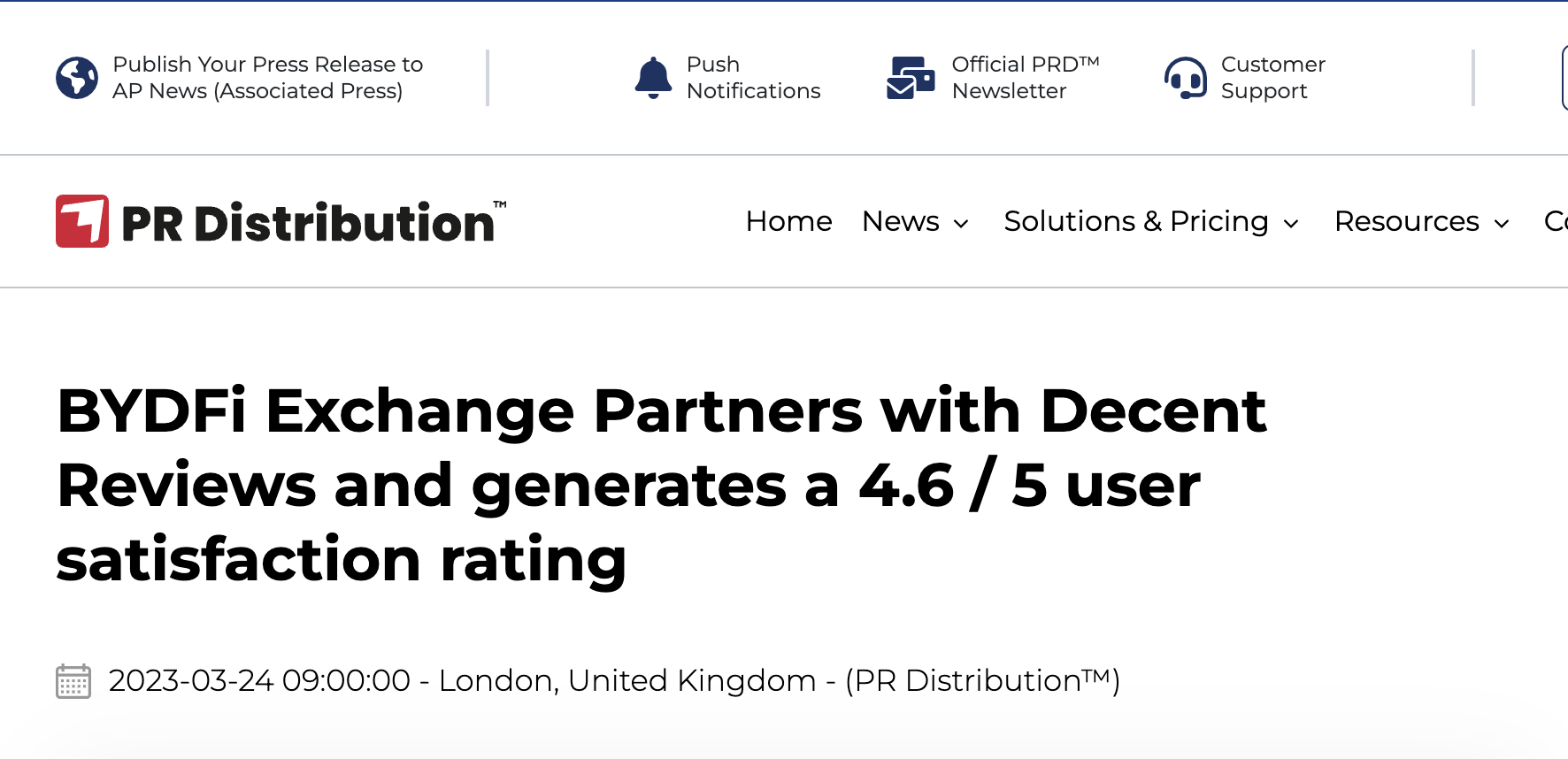
I love a good press release.
There are a tonne of bad ones out there and bad ways to do them, but there are also some great ones.
The secret to an effective press release is to know what you want to achieve with it. A lot of brands use them simply to release info on a new product or feature.
Which is boring AF and not going to get anyone to check out your brand.
In my mind, press releases have one purpose and one purpose alone. To get backlinks and wider reach.
To do that, you need a great piece of seed content.
Content topics for press releases
As mentioned above, press releases are there to raise the profile of your content and brand.
Press releases like the below do not do that.

This simply isn’t interesting to anyone and it’ll get lost in the various PR feeds.
To do well with generating buzz through press releases, you first need a great piece of seed content. Something that has unique analysis, custom stats, or something of interest will do much better.
For example, as everyone was going crazy about the Barbie Movie, the team at Search Intelligence created a piece for a client that detailed Margot Robbie’s workout plan.
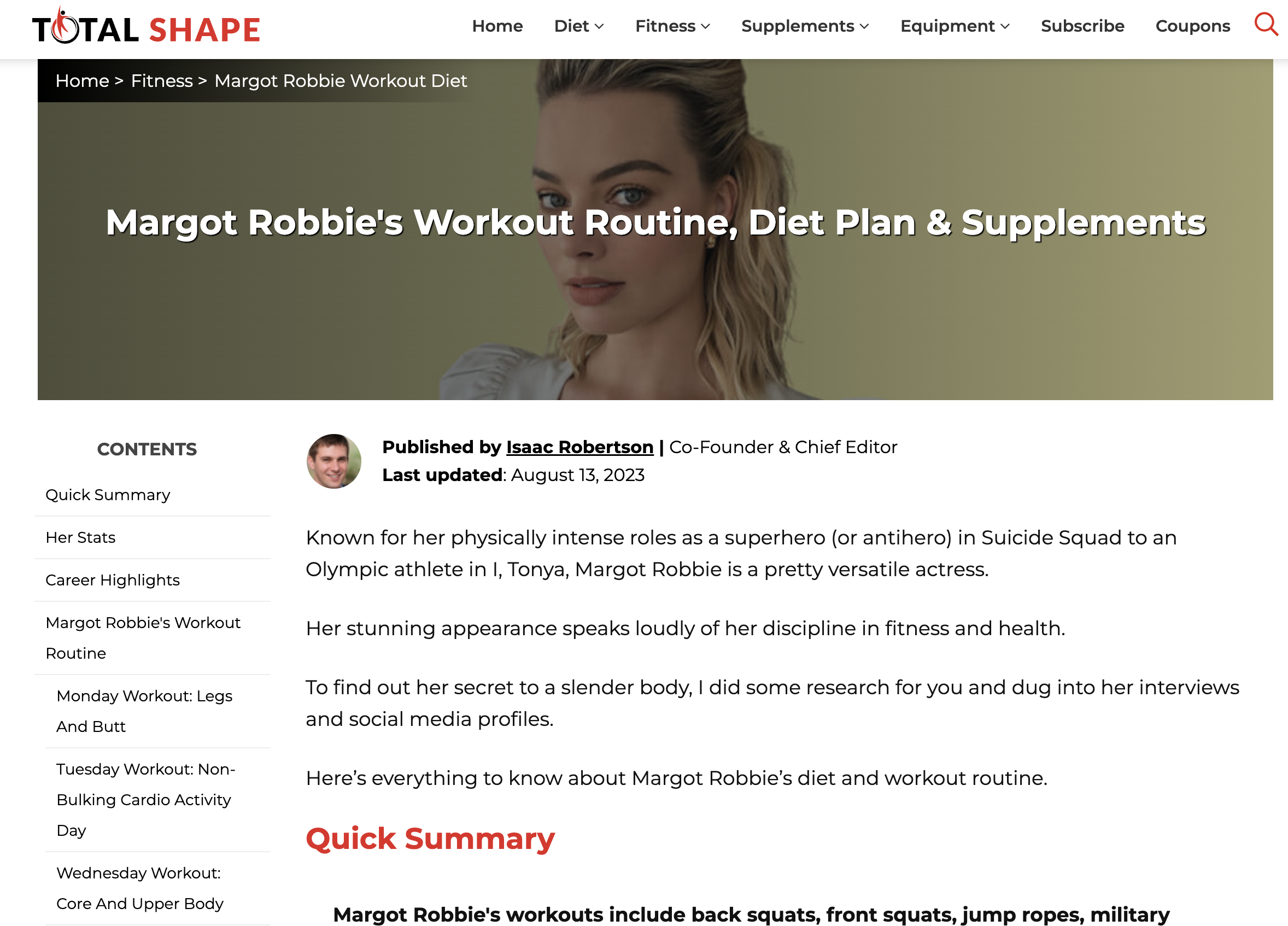
They then syndicated this to news publications as a press releases which earned them mentions and backlinks in major publications like The Sun.

This is what press releases are for. To get attention and mentions in big publications form something unique.
Pros of press releases
- Increased Visibility: Press releases can help brands and creators gain exposure and reach a wider audience. They are often picked up by various media outlets, resulting in increased visibility and brand recognition.
- Credibility and Trust: Press releases can enhance the credibility and trustworthiness of a brand or creator. When a reputable news source publishes a press release about a brand or creator, it adds legitimacy and authority to their image.
- Brand Awareness: Press releases are an effective tool for generating brand awareness. They allow brands and creators to share important news, updates, or announcements with their target audience, helping to create brand recall and familiarity.
- SEO Benefits: Press releases can contribute to improving search engine optimization (SEO) efforts. When press releases are published online, they can include keywords and backlinks that drive traffic to the brand or creator’s website, improving their online visibility and search engine rankings.
- Media Coverage: A well-crafted press release can attract the attention of journalists and media outlets, leading to potential media coverage. This can further amplify the brand or creator’s message, reaching a broader audience through trusted media sources.
Cons of press releases
- Limited Control over Message: When brands and creators issue press releases, they have limited control over how their message is interpreted and presented by the media. Journalists may choose to focus on certain aspects, omit important details, or even misinterpret the information provided.
- Oversaturation and Competition: Press releases are a popular tool for brands and creators to gain media coverage, leading to a high volume of releases being sent out daily. This oversaturation can result in intense competition for attention, making it more challenging for a particular press release to stand out and receive coverage.
- Potential for Negative Coverage: While the goal of a press release is to generate positive publicity, there is always a risk that the media may focus on negative aspects or provide critical coverage. This can damage the brand or creator’s reputation and lead to a negative perception among the audience.
- Reliance on Media Outlets: Press releases heavily rely on media outlets to pick up and cover the story. If journalists or publications choose not to cover the release, it can significantly impact the visibility and reach of the brand or creator’s message.
A good number of these can be mitigated by doing the upfront work to create something truly noteworthy though.
12. eBooks

I love an eBook.
Everywhere I go I usually have my Kindle with me.
I also love them from a creator standpoint. eBooks seem to have higher perceived value and trust than something like a blog post. A lot of folk think there are big hurdles to jump through to get one published, which couldn’t be further from the truth.
The fact is anyone can publish an eBook.
But more than the actual trust these things create, they can be great lead generator as they’re not only incredible lead magnets (thanks to the higher perceived value) but can be used to generate leads from marketplaces like Amazon.
I’ve done an analysis of Alex Hormozi and exactly how he did this in the past which is worth reading about.
Content topics for eBooks
You can cover pretty much anything with an eBook in terms of the topic.
However, you want to also focus on it being either highly entertaining or informative.
You can’t get away with a sales page as an eBook-type thing.
I know people who are earning a few hundred per day thanks to fiction eBooks. I also know others who create great lead generation thanks to B2B-focused eBooks.
If you position the book well, you can show up for relevant searches and create lead gen from ideal customers on autopilot.
Pros of eBooks
- Cost-effectiveness: eBooks eliminate the need for printing and distribution costs, allowing brands and creators to save money on production expenses.
- Accessibility: eBooks can be easily accessed and downloaded from anywhere in the world, making them readily available to a global audience.
- Reach and Exposure: eBooks can be distributed through various online platforms, increasing the potential reach and exposure for brands and creators.
- Monetization Opportunities: Brands and creators can generate revenue by selling eBooks or through advertising and sponsorship opportunities within the digital content.
Cons of eBooks
- Limited Branding Opportunities: Unlike physical books, eBooks provide limited opportunities for branding. Brands and creators may not be able to showcase their logo, design elements, or other branding elements on the cover or within the book itself.
- Incompatibility with Certain Devices: Not all e-readers or devices support all eBook formats. This can limit the reach of brands and creators, as some potential readers may not be able to access their eBooks on their preferred devices.
- Difficulty in Standing Out: With the increasing popularity of eBooks, the market has become highly saturated. It can be challenging for brands and creators to make their eBooks stand out among the sea of digital content available, potentially affecting visibility and sales.
- Piracy and Copyright Infringement: eBooks are susceptible to piracy and unauthorized distribution. This poses a significant risk for brands and creators, as their work can be easily copied and shared without their permission, resulting in lost revenue and potential damage to their reputation.
13. Sales pages
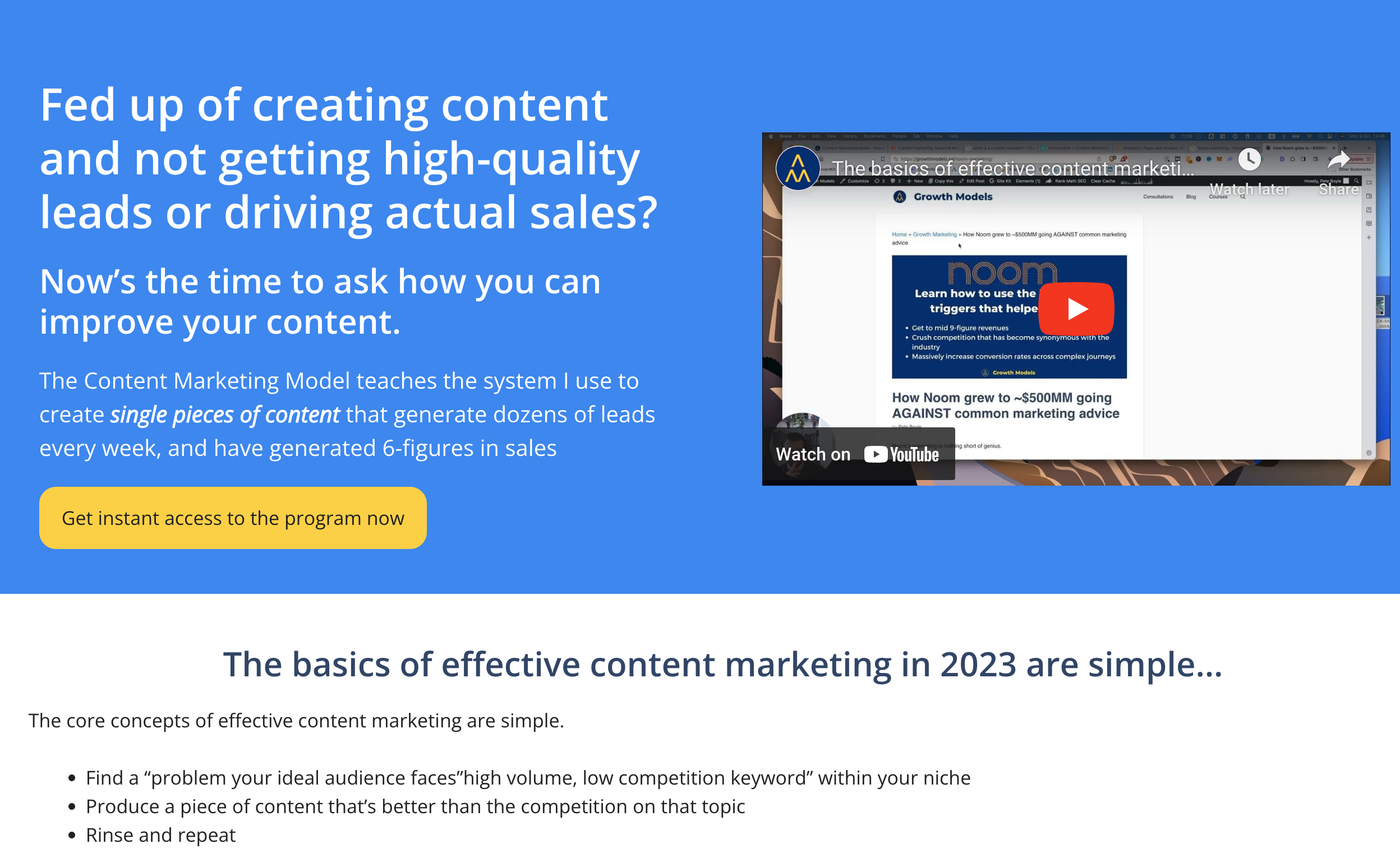
Sales pages were my bread and butter for years.
If you sell anything online, they are key to generating better sales and more money.
A bad sales page can sink an operation, whereas a good one can do lot of the heavy lifting and make up for deficiencies elsewhere.
These are really one of the final stops a lead will make when looking at your business before becoming a paying customer.
Which means, they have to highlight the benefits of your offer and downplay the risks.
They’re not easy to write and you need a good template and system to work from. Or you could just hire someone who knows their business to help you out.
Content topics for sales pages
Landing pages are there to make sales.
I’ve never understood people who are trying to get them to be SEO-optimised and all that. For me, its purpose is to get someone to open heir wallet. And that means that usually it’s not going to do well in search.
Stop thinking of them as anything other than a vehicle to make a sale and you’ll improve your pages 10X already.
Pros of sales pages
- Increased Sales: Sales pages are specifically designed to showcase products or services and persuade potential customers to make a purchase. This can lead to a significant increase in sales for brands and creators.
- Cost-Effective: Creating and maintaining a sales page is often more cost-effective than running traditional marketing campaigns or setting up physical stores. It eliminates the need for expensive print materials, physical retail space, and additional staff, resulting in lower overhead costs.
- Good Feedback Loops: I use a lot of sale pages to validate whether or not there’s interest in a product. I create the sales page first and add a “pre-sale” price. The sale page helps me identify whether or not people are interested and what it is they want in the product.
- Enables Other Channels: With a sale page in place you open the door for things like ads and email marketing. You have a conversion mechanism up and running so it’s just a case of getting traffic to it.
Cons of sales pages
- Potential information overload: Sales pages may overload customers with too much information about the product or service, leading to confusion and decision paralysis. Customers may feel overwhelmed and disengaged, ultimately impacting their purchasing decision.
- Risk of Being Too Vague: Between writing and auditing, I’ve worked on hundreds if not thousands of sales pages. The biggest risk I see is being too vague. A lot of brands just can’t nail the specificity needed to make sales which lowers the success of the brand overall.
14. Infographics
Infographics are, in my opinion, link-bait pieces.
They’re there to help you drive buzz and links to your site through things like PR and direct email outreach.
Alone, they’re not really enough to drive a sale or even educate on a deeper level, but thanks to the highly visual nature and stat-heavy focus, they’re great for grabbing attention and creating some buzz.
Content topics for infographics
You’re looking at the top of the funnel for a lot of infographics.
Something you can push out to get people talking and engaging with you. Focus on industry-wide issues and talking points to real help these hit home.
Pros of infographics
- Visual Appeal: Infographics are visually appealing and engaging, making them an effective tool for brands and creators to capture the attention of their audience.
- Simplified Information: Infographics simplify complex information into easily digestible and understandable chunks, making it easier for viewers to grasp and retain information.
- Increased Engagement: Infographics are more likely to be shared and liked on social media platforms, leading to increased brand exposure and engagement with the target audience.
- Improved Brand Awareness: By creating visually appealing and informative infographics, brands can establish themselves as authorities in their respective industries, increasing brand awareness and recognition.
- Easy to Share: Infographics are highly shareable, allowing brands and creators to extend their reach and attract a wider audience through social media sharing and embedding on websites.
Cons of infographics
- Limited Information: Infographics often have limited space to convey detailed information. This can be a drawback for brands and creators who want to provide in-depth information about their products or services.
- Oversimplification: Infographics tend to simplify complex concepts or data, which may result in oversimplification or distortion of information. This can be problematic for brands and creators who need to accurately represent their offerings.
- Design Limitations: Creating visually appealing and effective infographics requires design skills and resources. Brands and creators who lack these resources may struggle to create high-quality infographics that effectively represent their brand.
- Accessibility Challenges: Infographics heavily rely on visual elements, which can pose accessibility challenges for individuals with visual impairments or other disabilities. This can exclude a portion of the audience from fully understanding the information being presented.
- Limited Flexibility: Once an infographic is created, it can be difficult to update or modify without starting from scratch. Brands and creators who frequently update their information may find this lack of flexibility inconvenient.
- Misinterpretation: Infographics rely on visual cues and symbols, which can be open to interpretation. This can lead to misinterpretation of the information being presented, potentially impacting the brand’s message and credibility.
- Costly and time-consuming to produce: You need a team to collect and analyse data, and then the ability to turn it into something that actually works from a visual perspective. It can be quite costly and time-consuming to produce.
15. User reviews and testimonials
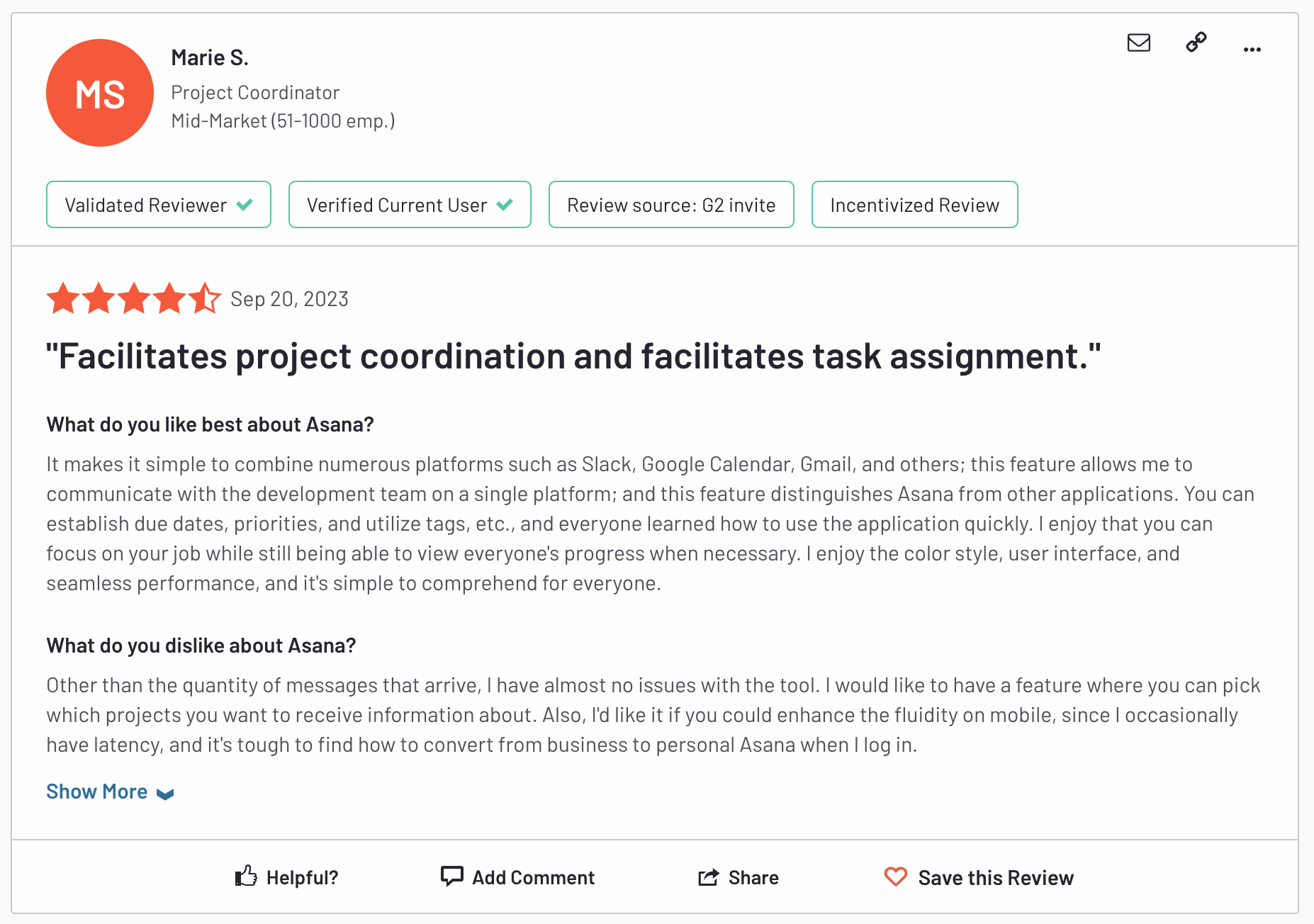
User reviews and testimonials are gold dust for marketers.
They’re not only great for audience research and figuring out what people like and disliked about your brand, but they’re powerful trust builders.
As a brand you have a vested interest in people buying from you, so when you say something is “the best” people won’t believe you.
Get a customer to say that though and you’ve got something others will believe.
It builds trust and removes the last-minute resistance.
Content topics for reviews and testimonials
These are at the end of the purchase journey. they’re for bottom-of-funnel content and enrich assets like sales pages, VSLs etc.
Anything where the user is considering whether or not to buy, you should be using user reviews.
I’d also recommend partnering with marketplaces people use to compare different products. Places like G2, TrustPilot etc.
These might not be great sites and the reviews might not mean a lot to you, but a lot of customers use them to you, but a lot of customers use them in their research.
Pros of user reviews
- Authenticity: User reviews provide genuine feedback and opinions from real customers, giving a more authentic perspective on the brand or creator.
- Trustworthiness: Reading user reviews allows potential customers to gauge the trustworthiness and reliability of a brand or creator based on the experiences shared by others.
- Transparency: User reviews offer transparency about the quality, performance, and value of products or services, helping consumers make informed decisions.
- Insight into Product/Service: User reviews provide valuable insights into the features, benefits, and limitations of a product or service, helping potential customers understand what to expect.
- Diverse Perspectives: User reviews offer a range of perspectives, allowing consumers to consider different opinions and experiences before making a purchase or engaging with a creator.
- Improvement Opportunities: Brands and creators can utilize user reviews as constructive feedback to identify areas for improvement, enhancing their products, services, or content.
Cons of user reviews
- Bias and Subjectivity: User reviews are highly subjective and can be influenced by personal preferences, experiences, or even biases. This makes it difficult to determine the true quality or value of a brand or creator based solely on user reviews.
- Lack of Credibility: It’s challenging to verify the credibility and authenticity of user reviews. Some reviews may be fake or manipulated, either by the brand or its competitors, which can mislead potential consumers.
- Limited Perspective: User reviews provide a limited perspective as they are based on individual experiences. What may be a negative experience for one person might not be the case for others. This can lead to an inaccurate representation of the brand or creator.
- Inconsistent Quality: User reviews can vary widely in terms of quality and reliability. Some reviews may lack sufficient detail or provide vague information, making it difficult to make an informed decision based on them.
- Lack of Expertise: User reviews often lack the expertise or knowledge needed to assess the technical or professional aspects of a brand or creator. This can result in misleading or inaccurate information being shared.
- Limited Sample Size: Depending on the popularity of the brand or creator, user reviews may not represent a significant portion of the consumer base. This limited sample size can make it challenging to draw accurate conclusions from the reviews.
- Lack of Context: User reviews often lack context, such as the reviewer’s background, preferences, or expectations. This can make it challenging to gauge how relevant or applicable their feedback is to your own needs or preferences.
16. Ads
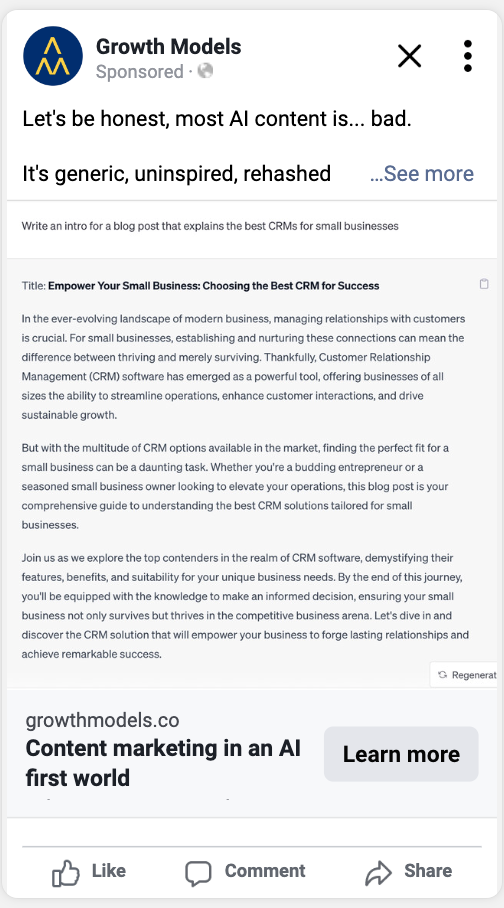
Ads are where a lot of brands will go first to try and drum up some interest.
Personally, I think ads should be later on in the development and growth cycle. Make sure you have a good product first and then ensure your growth model is working to attract and convert people.
Once you know the system works, ads can be used to add fuel to the fire.
There are also plenty of different ad platforms and you’ve got to know where your ideal users hang out before putting money into anything. getting the wrong ad platform will doom you to failure before you even start.
Content topics for ads
Ads are really for getting people into your funnel.
You want to use them to direct a targeted user base towards something like…
- Sales page
- VSL / Free Training
- Content (if you have conversion elements set up on it)
It kind of falls under the “getting buzz” category. They’re there to grab attention, but then also to direct people to assets that have more of a conversion focus.
Pros of running ads
- Increased Visibility: Running ads for brands and creators can significantly increase their visibility among the target audience. Ads allow them to reach a wider range of potential customers or followers, increasing their brand or personal recognition.
- Brand Awareness: Running ads can help in building brand awareness. By consistently displaying their ads, brands and creators can create a strong brand image and make their target audience more familiar with their products or content.
- Targeted Marketing: Ads can be specifically targeted to reach a particular demographic or audience. This allows brands and creators to focus their advertising efforts on individuals who are more likely to be interested in their products or content, increasing the chances of conversion.
- Increased Sales or Revenue: Running ads can lead to an increase in sales or revenue for brands and creators. By reaching a wider audience and effectively promoting their products or content, ads can drive more traffic to their websites, social media pages, or physical stores, resulting in higher sales.
- Quickly Scalable: If you’re getting a positive ROI on your ads you can easily turn up the numbers and see both your traffic and sales numbers jump. It’s one of the best ways to quickly scale up.
Cons of running ads
- Intrusive and disruptive: Ads can be seen as intrusive and disruptive to the user experience, especially when they pop up unexpectedly or interrupt the content being consumed.
- Ad blindness: Many users have developed ad blindness, meaning they have become so accustomed to seeing ads that they simply ignore or overlook them, reducing their effectiveness.
- Ad fatigue: Constant exposure to ads can lead to ad fatigue, where users become tired and annoyed by repetitive or irrelevant advertisements, leading to negative associations with the brand or creator.
- Lack of authenticity: Running ads can sometimes compromise the authenticity of the content being produced, as it may be perceived as a form of selling out or compromising the creator’s integrity.
- Cost: Running ads can be expensive, especially for smaller brands or creators with limited budgets. The cost may not always justify the returns, making it a less desirable option.
- Competition and clutter: The digital advertising space is highly competitive and cluttered, making it difficult for ads to stand out and capture the attention of users amidst the sea of other advertisements.
17. Podcasts
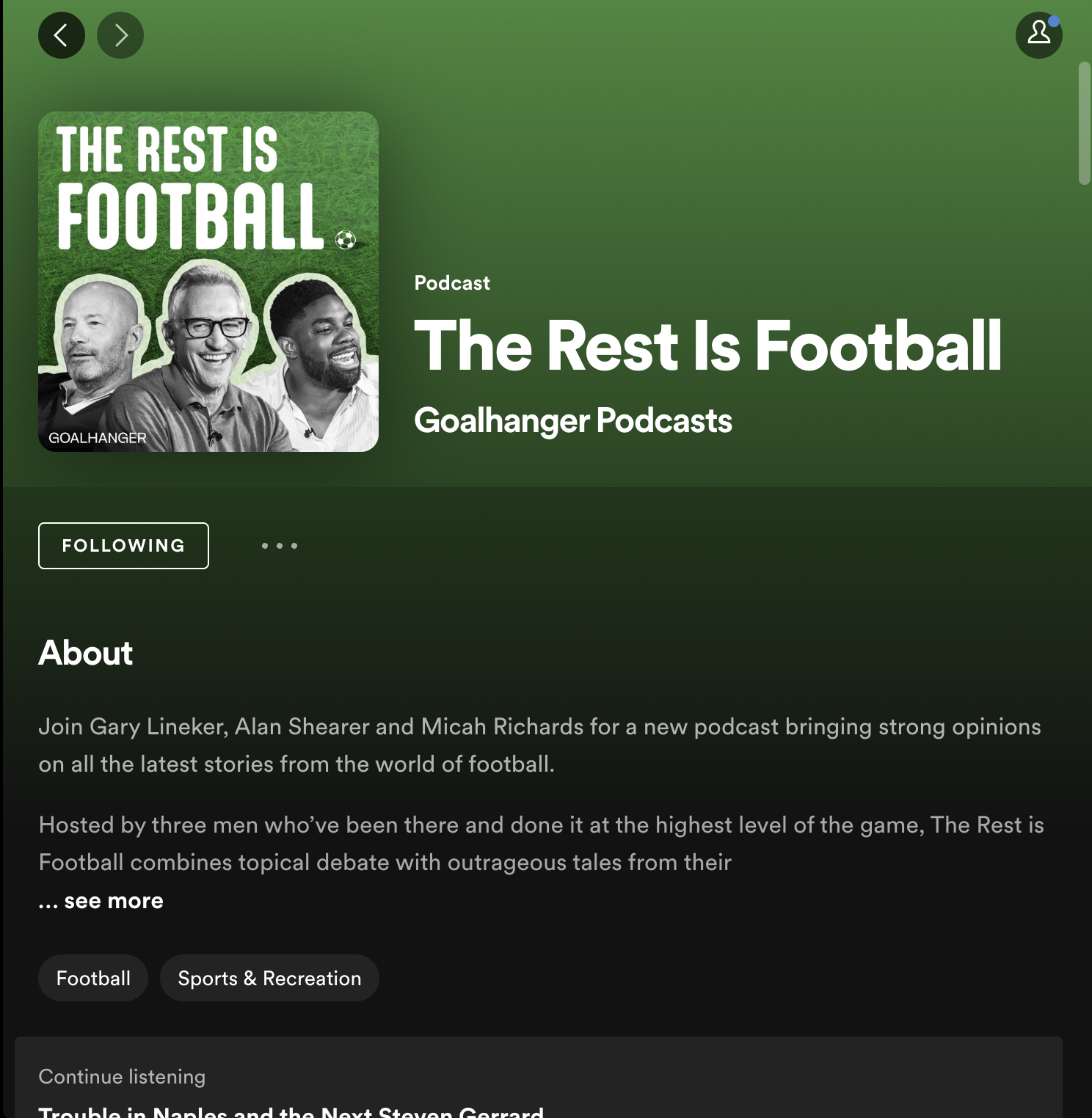
Podcasts are another content type that’s blown up in recent years. Feels like everyone with an opinion wants to set one of these up right now.
They do have their benefits as you can cover a wide range of content categories with them. You can use them to generate buzz, build trust, and even push listeners towards a sale.
They can be a great value add, but a lot of people are spinning these up without any user desire and no differentiation which makes it an action of futility.
Content topics for podcasts
As mentioned above, you can use these really for any content category.
However, when you look at the best out there they tend to be one of the following…
- Expert insight (as in real experts not a 6-monther who thinks they know it all)
- Detailed analysis and information
- Pure entertainment
All of these are a lot harder than you might think. They can be achieved, but it’s not as simple as sitting down with mates for a chat.
Pros of podcasts
- Authenticity and credibility: Through podcasts, brands and creators can establish themselves as industry experts, building trust and credibility among their listeners.
- Long-form content: Podcasts offer the opportunity to delve deeper into topics and provide more detailed information, allowing brands and creators to showcase their expertise.
- Brand storytelling: Podcasts provide a platform for brands and creators to share their unique stories and values, creating a deeper connection with their audience.
- Monetization opportunities: Podcasts offer various monetization options, such as sponsorships, advertisements, and merchandise sales, providing additional revenue streams for brands and creators. However, it’s not easy to get monetized as you need a pretty big audience.
- Building a community: Podcasts foster a sense of community among listeners, allowing brands and creators to build a loyal fan base and encourage audience interaction and engagement.
Cons of podcasts
- Limited Visual Appeal: Unlike videos or images, podcasts rely solely on audio content, which can limit the visual appeal for brands and creators. This can make it challenging to capture and maintain the attention of the audience.
- Difficulty in Monetization: While some popular podcasts may generate revenue through sponsorships or advertisements, it can be harder for smaller brands and creators to monetize their podcasts. Finding the right advertisers or sponsors that align with the podcast’s content can be a time-consuming process.
- Lack of Discoverability: With the increasing number of podcasts available, it can be difficult for new brands and creators to stand out and gain visibility. Without proper marketing strategies or a strong existing audience base, it can be challenging to attract new listeners and grow the podcast’s reach.
- Time and Resource Intensive: Creating high-quality podcast content requires significant time and resources. From planning and scripting episodes to recording, editing, and post-production, it can be a time-consuming process that may require additional equipment and expertise.
- Limited Audience Engagement: Compared to other mediums, podcasts offer limited opportunities for audience engagement. While listeners can leave reviews or comments, the lack of real-time interaction and visual cues can make it harder for brands and creators to build a strong connection and gather immediate feedback from their audience.
How to choose what kind of content type is right for your brand?
The way to figure this out is simple.
You need to focus on one or two content types that you can be consistent with.
And by consistent, I don’t mean daily, weekly, or monthly. There’s no set cadence for this as it depends on you.
When I say consistent, I mean, how consistently can you churn out good content.
If it’s weekly, do weekly. If it’s monthly, do monthly.
Your focus should be on quality first, then move to scaling up the production schedule once you’re starting to get things down.
So choose something you can do consistently with high value if you want it to succeed.
As an example, I can write like a MFer so I choose to write.
Simple as that.
